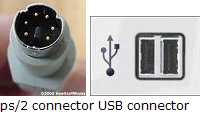by Gabe Goldberg
Buying a new PC needn’t involve replacing all your older PC devices, no matter what the friendly store salesperson suggests. Though newer PCs often have only USB (Universal Serial Bus) ports, an amazing assortment of adapters are available to connect older sorts of plugs to USB ports.
To see what’s available, Google the connections you need to handle. For example, searching for
ps/2 to usb
finds discussions of how adapters work, what they look like, problems that can occur with them, and abundant options for buying them. If you’re short on USB ports there’s even a gadget that connects two PS/2 devices to a single USB port.
If you’re really out of USB ports, a USB hub allows many USB devices to connect to a single USB port. Remember that most USB-attached devices are powered by the USB port to which they connect (exceptions are devices with separate power supplies). For devices not needing much power — USB thumb drives and such — that’s fine, even providing power through a hub. But a computer’s USB port can’t power many more demanding devices such as external hard drives; for those, a powered hub may be required, providing its own power to devices plugged into it. Fortunately, hubs — even powered — aren’t very expensive.
Other adapter variations convert PS/2 to 9-pin connector, 9-pin to 25-pin (parallel port), gender to gender (allowing plugging a female cable into a female port, or male-into-male), and almost any imaginable pairing.
But electronic connection is just half the issue faced; you also need support from software you’ll use: the Windows operating system and applications. So before assuming that old devices will work with your new PC, check appropriate Microsoft lists of Windows supported devices. Also ensure that necessary applications run under the Windows version you’ll use and if you’ll upgrade applications, verify that new versions support the devices you want to use with them.
You may need to install specific software drivers to match devices to applications and Windows, but the process sounds more complicated than it is. The easiest way to do it is starting by listing everything (hardware and software) you’d like to use with a new computer, then making two columns and checking off that each component works with the new Windows version and necessary applications. Don’t give up on items not explicitly listed as supported: Just as you Googled to find adapters, search for information and discussions on what you want to use. You may find resources which provide missing links!
Gabe Goldberg (tiplet@gabegold.com), a lifelong computer pro and technology communicator, has written three books and hundreds of articles for audiences including techies, baby boomers and senior citizens. He enjoys sharing tips and pointers that help people use and have fun with technology.

